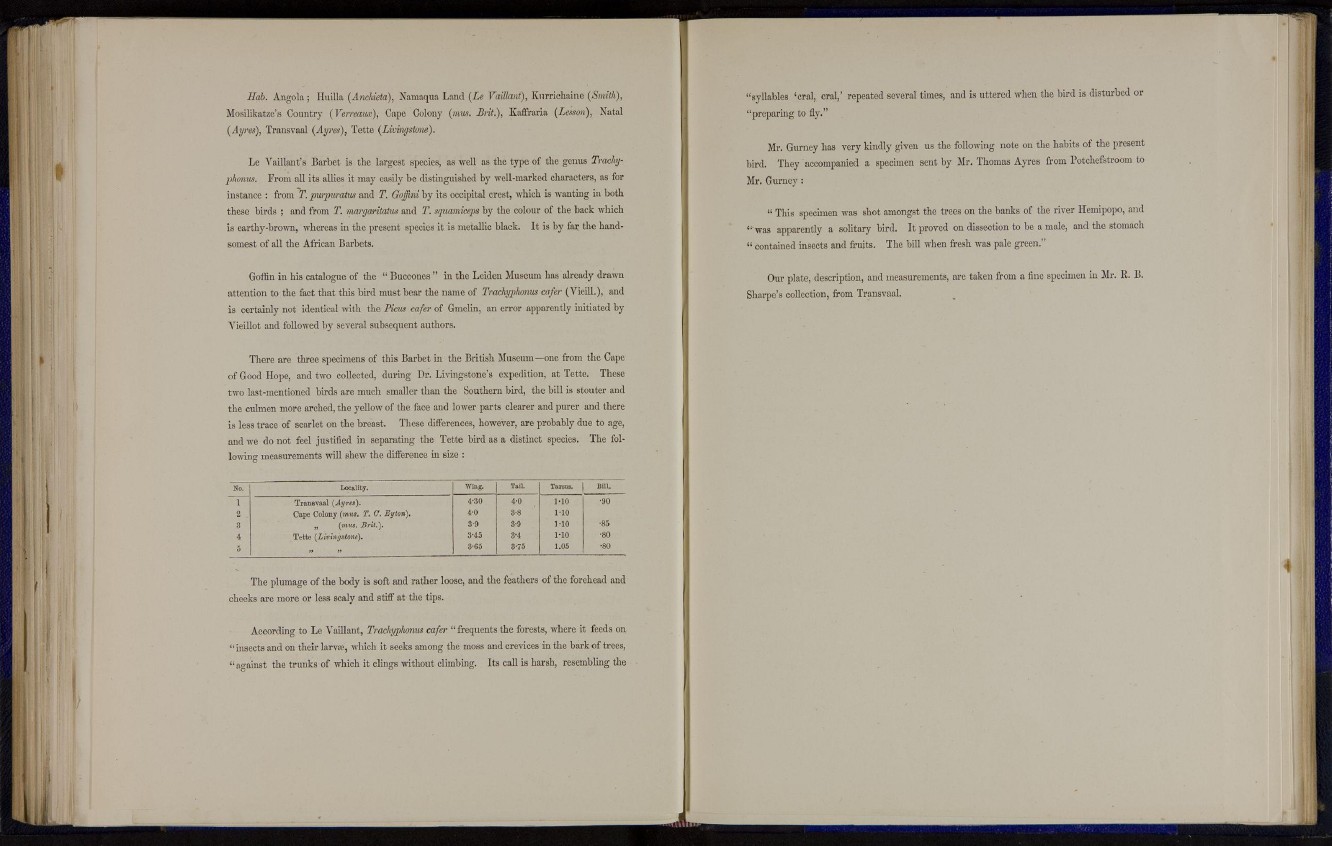
Hub. Angola ; Iluilla (Anchieta), Namaqua Land (Le Vaillant), Kurrichainc (Smith),
Mosilikatze's Country (Verreaiuv), Cape Colony (mils. Brit.), Kaffraria (Lesson), Natal
(Ayres), Transvaal (Ayres), Tette (Livingstone).
Le Vaillant's Barbet is the largest species, as well as the type of t he genus Trachyphonus.
From aU i ts allies it may easily be distinguished by well-marked characters, as for
instance : from T. purpuratus and T. Goffmi by its occipital crest, which is wanting in both
these birds ; and from T. margaritatus and T. squamiceps by t h e colour of the back which
is earthy-brown, whereas in the present species it i s metallic black. It is by far the handsomest
of all the African Barbets.
Goffin in his catalogue of the " Bucconcs " in the Leiden Museum has already drawn
attention to t h e fact that this bird must bear the name of Trachyphonus cafer (VieilL), and
is certainly not identical with the Picus cafer of Gmelin, an error apparently initiated by
A'ieillot and followed by several subsequent authors.
There are three specimens of this Barbet in the British Museum—one from the Cape
of Good Hope, and two collected, during Dr. Livingstone's expedition, at Tette. These
two last-mentioned birds are much smaller than the Southern bird, the bill is stouter and
the cuhnen more arched, t h e yellow of t h e face and lower parts clearer and purer and there
is less trace of scarlet on t h e breast. These differences, however, are probably due to age,
and we do not feel justified in separating the Tette bird as a distinct species. The following
measurements will shew the difference in size :
No. Locality. Wing. Tail. Tareus. Bill.
1 Transvaal (Ayres). 4-30 4-0 MO •90
2 Cape Colony (mus. T. 0. Eyton). 4-0 3-8 1-10
3 „ (mus. Brit.). 3-9 3-9 MO •85
4 Tette (Livingstone). 3-45 3-4 1-10 •80
5 „ 3-65 3-75 1.05 •80
The plumage of t h e body is soft and r a t h e r loose, and t he feathers of t h e forehead and
cheeks are more or less scaly and stiff at t h e tips.
According to Le Vaillant, Trachyplwnus cafer " frequents the forests, where it feeds on
" insects and on their larva?, which it seeks among the moss and crevices in the bark of trees,
" against the t r u n k s of which it clings without climbing. Its caU is harsh, resembling the
"syllables 'cral, cral,' repeated several times, and is uttered when the bird is disturbed or
"preparing t o fly."
Mr. Gurney has very kindly given us the following note on t h e habits of t he present
bird. They accompanied a specimen sent by Mr. Thomas Ayres from Potchefstroom to
Mr. Gurney :
" This specimen was shot amongst the trees on the banks of the river Hemipopo, and
" w a s apparently a solitary bird. It proved on dissection to be a male, and t he stomach
" contained insects and fruits. The bill when fresh was pale green."
Our plate, description, and measurements, are taken from a fine specimen in Mr. R. B.
Sharpe's collection, from Transvaal.